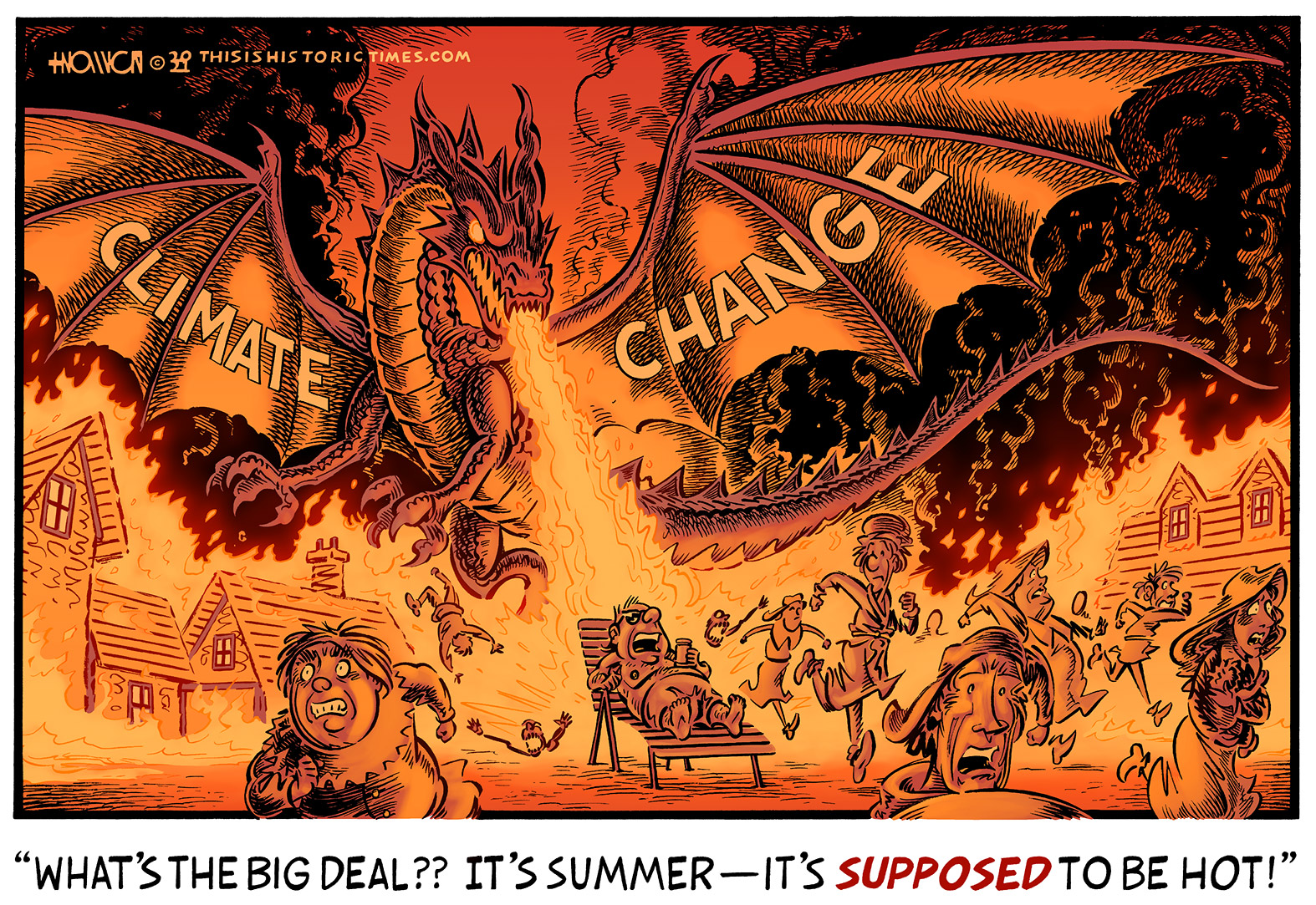There’s No Such Thing As A Dragon

I’ve been wanting to produce a sequel to an earlier cartoon I drew about climate change denialism for years, and the series of extreme heat waves the Western United States suffered this summer finally provided the perfect opportunity.
Unfortunately, I wasted more than two months trying to develop a concept different from the one presented above. That idea ultimately proved unworkable because it featured an environment which was supposed to function as the metaphor, rather than a singular object, and I couldn’t come up with a way to clearly establish that specific connection without making the speaking character’s dialogue too awkward and unnatural.
It’s kind of too bad, because the other concept, which would have been set in Hell, had more room for a lot of funny little details, including faceless demons cooking people on skewers like hot dogs over a campfire, and even a cameo by the recently-deceased, mass-murdering war criminal Donald Rumsfeld being justly cast into the inferno of eternal damnation, but then again I suppose that lack of focus may have been part of the problem.
Some of the research I did for the earlier concept, such as William Blake’s “Red Dragon” series of paintings, did prove at least slightly useful for the concept I completed above. I have very little experience drawing dragons—I think the only one I’ve included in a cartoon before was an Eastern/Chinese dragon rather than a Western/European one—so I still ended up sinking even more time into studying other representations and artwork to learn how to draw one.
Even after all that, I’m not entirely satisfied with my treatment of the fictional creature’s limbs. While European dragons have throughout history generally been depicted as having four legs and a pair of wings, there is no vertebrate in the real world which features such an arrangement, since all reptiles, birds, and mammals descended from a common ancestor with four legs, and those that fly (as opposed to merely gliding) adapted two of their legs into wings.
In other words, for a dragon to have four legs and a pair of wings, it would have had to have evolved from some kind of six-legged, non-flying vertebrate, and there’s even less of a precedent for that in nature than there is for fire-breathing!
A lot of other people trying to design dragons for fiction and popular entertainment lately seem to have gotten hung up on this, too, and the preferred solution seems to be making their dragons two-legged, with wings adapted from their forelegs. The dragons in Game of Thrones and Peter Jackson’s version of Smaug the Terrible are among the most notable examples, and while the infamous “slut dragons” episode of Rick & Morty features dragons of both the four-legged and two-legged varieties, the one at the core of the story is still the kind that uses its forelegs as wings.
This probably would have been my solution as well, but a two-legged, dragon-like fantasy monster with wings is not strictly considered a dragon, it is a wyvern, and for various reasons I didn’t want there to be any such ambiguity in the illustration.
Chief among these was the cartoon’s title, which comes from one of my favorite children’s books, There’s No Such Thing As A Dragon, by 20th century cartoonist Jack Kent. It’s about a kid who wakes up one morning to find a small dragon at the foot of his bed. The dragon (which, incidentally, has four legs but is also wingless, technically making it a drake) follows him to breakfast, but whenever he points it out to his mom, she simply replies, “There’s no such thing as a dragon.”
Each time she dismisses the dragon’s existence, it grows larger and larger, until finally it’s filling up the entire house. Eventually, it goes running down the street with the house on its back, chasing after a bread delivery truck.
Finally, the mom has to acknowledge that the dragon exists, at which point it promptly shrinks back down to a more manageable size.
Like a lot of children’s books, I doubt I appreciated or was even aware of the major themes when I was a kid. I just liked it because it was an amusing story with funny pictures. Nowadays, though, I can recognize a lesson in it which is something like, “The longer you ignore a problem, the bigger it gets, until it reaches a scale that’s nigh-impossible to deal with.”
I thought that was a very appropriate message when it came to the topic of climate change, seeing as even many elected representatives who at least claim to believe in it still refuse to stop actively making it worse. That was what convinced me to develop the concept above.
What a great cartoon it would have made, if only I’d finished it prior to the very last day of summer, huh?
Oh well. The “good” news is that it will still be just as relevant next summer, as well as the summer after that, and probably every other subsequent summer for the rest of our lives. 😛


Leave a Response